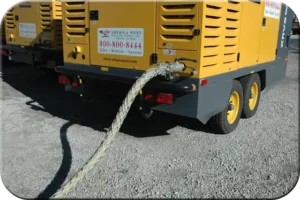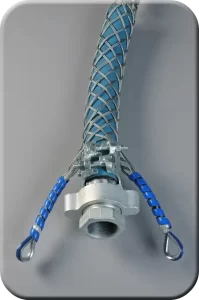Product Details


Whipsock – the best high-pressure hose safety device.
Prevent accident, injury, and death! These are the best high-pressure hose restraints available because the stocking style woven steel grips the hose more securely over a larger area. Abrasion and wear and tear usually take place near fittings, which may result in a rupture. If this happens within the covered area, additional safety occurs that would never occur with a standard whip check. The woven steel can also help prevent abrasion to the hose underneath.
These Whipsocks are not restricted to just air hoses, but can be used on any application where high-pressure hoses are used, air, water, hydraulic, slurry, etc. The key is the two mounting points and the long gripping area. Obviously the two anchoring points and shackles must be rated for the application.
Standard whip checks allow a great amount of whip to occur, but the dual leg Whipsock keeps the hose under complete control. This could mean the difference between life and death.
Safety First! Always use your personal safety gear and make sure all equipment has been inspected before use.
| Nominal Hose Size | Hose OD | Overall Length | Approx. Weight | Breaking Strength |
|---|---|---|---|---|
| 3/8" | 0.315 - 0.5512" / 8-14 mm | 15.75" | 1# | 2866 # |
| 1/2" | 0.5515 - 0.7874" / 14-20 mm | 21.65" | 2# | 2866 # |
| 7/8" | 0.7874 - 1.181" / 20-30 mm | 25.20" | 2# | 6173 # |
| 1" | 1.181 - 1.575" / 30-40 mm | 34.25" | 2# | 6173 # |
| 1 1/4" | 1.575 - 1.969" / 40-50 mm | 38.19" | 3# | 6173 # |
| 1 1/2" | 1.969 - 2.362" / 50-60 mm | 49.21" | 4# | 6173 # |
| 2" | 2.362 - 2.756" / 60-70 mm | 51.18" | 5# | 20,500 # |
| 2 1/2" | 2.756 - 3.346" / 70-85 mm | 53.15" | 6# | 20,500 # |
| 3" | 3.346 - 3.937" / 85-100 mm | 72.44" | 7# | 27,120 # |
| 3 1/2" | 3.937 - 4.724" / 100-120 mm | 72.05" | 9# | 27,560 # |
| 4" | 4.724 - 5.512" / 120-140 mm | 86.61" | 11# | 35,270 # |
| 6" | 5.512 - 7.087" / 140-180 mm | 93.31" | 17# | 35,270 # |

Make sure you install the Whipsock on the hose prior to installing fittings. Trust us, this is from experience!
The most important aspect is that the mounting point is strong enough to handle the force should a fitting fail.
Air Hose Safety
U.S. Department of Labor Mine Safety and Health Administration 30CFR 56/57.13021 High-Pressure Connection (100 psi and up) states: Except where automatic shutoff valves are used, safety chains, or other suitable locking devices shall be used at connections to machines of high-pressure hose lines of ¾-inch inside diameter or larger and between high-pressure hose lines of ¾-inch inside diameter or larger, where a connection failure would create a hazard.
All high-pressure hose assemblies should be viewed as potential hazards. It is the user’s responsibility to identify the application and any special conditions that the hose assembly must meet.





Please follow these precautions prior to using any high-pressure hose:
1. Confirm all hoses, fittings, and safety devices are rated for the specific requirements and inspect all items to ensure they are in proper working order.
2. Make sure all couplings are matched properly. (Do not use mismatched couplings.) Double-check torque on clampMakes. Make sure fittings and clamps are not worn out. Never assume that the fittings were installed properly; check for yourself.
3. Use quality safety devices to prevent whipping if a connection fails.
4. Hose should be kept free of oil and grease to help prevent deterioration. Keep hose clear of items that can cause abrasion.
5. Confirm all couplings are properly secured and safety devices are in place prior to adding pressure.
6. Above all, NEVER, NEVER, NEVER disconnect a coupling under pressure. Confirm without a doubt that pressure has been removed prior to uncoupling. Keep the safety device in place!
7. Make sure all personnel are aware of hazards and are properly trained on equipment usage.
Below are some incidents that could have been prevented by using the appropriate Whipsock.
1. An exploration driller’s assistant was struck on the head by a large diameter compressed air hose which blew off its fitting on a cyclone/sampler. He received serious head injuries, which proved fatal. The air hose was held by a hose clamp on the fitting, with no restraining chain or sling to prevent the hose from thrashing around.
2. A driller employed on an exploration rig was struck on the upper right side of his body and arm by a 3” diameter cyclone/sampler air hose which blew off its fitting above the driller’s operating platform. He received serious injuries to his ribs and right lung and a severely crushed right arm which had to be amputated. The air hose was held on the fitting by a claw-type 4 bolt hose clamp. The hose assembly was fitted with a commercially made whip check using 6 mm diameter wire rope, which failed.
Tests have shown that a 6 mm whip check failed at 2320#, whereas an 8 mm whip check failed at 15,800#. Our 3” Whipsock has a breaking strength of 27,000#.
3. A high-pressure top-drive rotary hose ruptured under a pressure of 3000 psi. The hose fell to the rig floor and knocked down a roughneck. He was not seriously hurt, although the incident could have been potentially serious.
WHAT CAUSED IT: The hose was rated for 5000 psi working pressure. An investigation following the incident revealed that the restraining safety clamps were not correctly placed around the yellow marker bands marked “Safety Clamp Here.” Instead, the clamps were placed closer to the threaded union where the diameter of the hose is larger.
In this case the hose ruptured when it blew out of the end ferrule. As the safety clamp was in the wrong position, it did not properly restrain the hose, which passed completely through it. In addition, it was found that the safety clamps were too large to grip the smaller diameter of the hose below the ferrule.
Using our Whipsock would have provided a longer and flexible gripping area over the different hose diameters.
4. Two workers noticed that a bull hose (flexible hose between two rigid pipes) connection was improperly attached. They were not aware that the system was under pressure when they tried to fix it. Consequently one was killed and the other seriously injured.
If our 4-eyed sock had been in place, the whipping action could have been eliminated, but above all it is absolutely imperative to confirm there is no pressure in the lines and use proper lockout procedures.
 4-Eyed Whipsock
4-Eyed Whipsock
Available by custom order to fit your needs
A drill crew attached a hose to a mud pump that did not have an identical fitting (the threads were slightly different, as was the pressure rating). At 2000 psi the coupling failed. Luckily no one was standing near the mud pump at the time.
Due to the high-pressure our Whipsock would have a greater chance of success than a standard whip check, this also points out the importance of proper connections.


